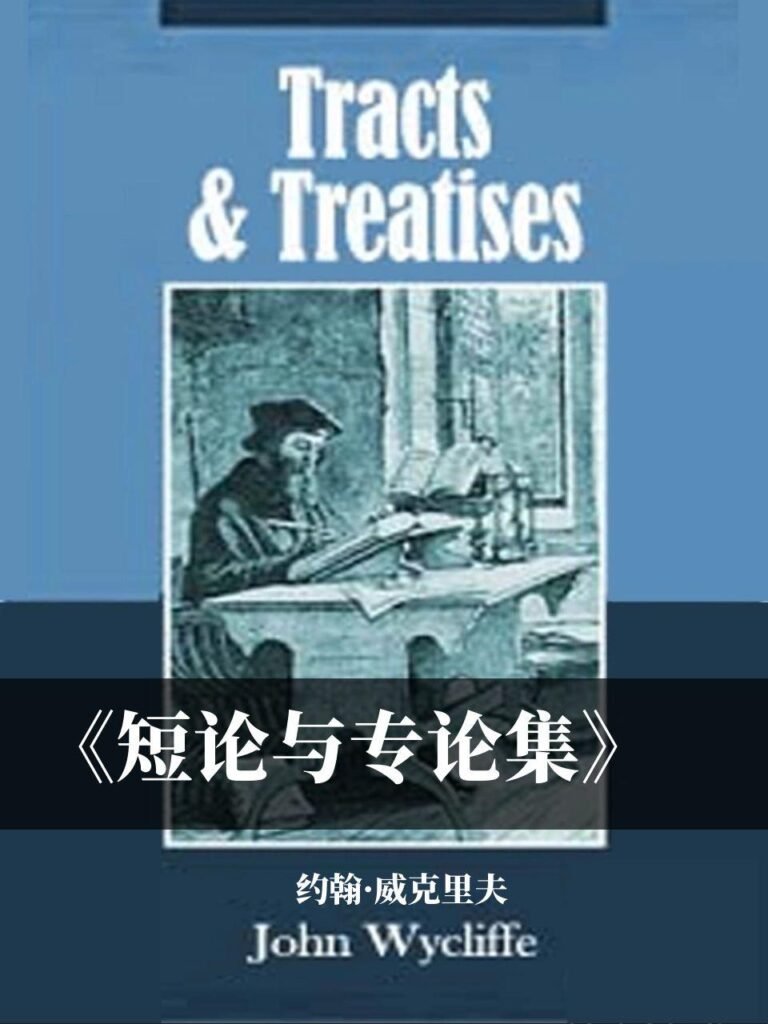|
Getting your Trinity Audio player ready... |
Modernized, formatted, corrected, and annotated (in blue) by William H. Gross www.onthewing.org
现代化、格式化、修正并由威廉·H·格罗斯注释(蓝色部分)www.onthewing.org
Modernization is based on Middle-English meanings, which was the vocabulary of Chaucer.
现代化是基于中古英语含义,这是乔叟的词汇。
Wycliffe’s translation of the Latin Vulgate is historically significant.
威克里夫对拉丁文武加大译本的翻译具有历史意义。
中文下载

Therefore, although modernized in part, his wording has been retained as much as possible, rather than substituting a current version.
因此,尽管部分现代化,但尽可能保留了他的措辞,而不是替换为当前版本。
A biographical notice of Tyndale has this to say about Wycliffe’s previous translation (from the Parker Society’s Tyndale, Doctrinal Treatises, 1848): “Wicliffe’s version also had this considerable defect, that whereas there was no one in Oxford in his days who knew anything of Greek, he could only translate from the Latin Vulgate; and consequently he had incorporated all of its erroneous renderings into his text.
关于丁道尔的传记记录对威克里夫之前的翻译有这样的说法(摘自帕克协会的丁道尔《教义论文》,1848年):”威克里夫的版本也有这个重大缺陷,即在他的时代牛津没有人懂希腊文,他只能从拉丁文武加大译本翻译;因此他将其所有错误的翻译都纳入了他的文本中。
But besides this, the unsettled state of language, in our illiterate nation, had already made Wicliffe’s English among the things which were passing away.
但除此之外,在我们这个文盲国家中语言的不稳定状态,已经使威克里夫的英语成为正在消逝的事物之一。
‘The ghiftis and the clepyng of God ben without forthynkyng,’ or ‘He made us saaf bi waisshchyng of aghenbigetyng and aghen newing,’ (Wicliffe’s version of Rom. 11.29, and Tit. 3.5), would scarcely have been intelligible to Tyndale’s contemporaries, and would have sounded painfully uncouth to the next generation.”
‘神的恩赐和呼召是没有后悔的’,或’祂借着重生的洗和更新拯救了我们’(威克里夫版本的罗马书11:29和提多书3:5),对丁道尔的同时代人来说几乎难以理解,对下一代人来说听起来会非常粗俗。”
In this modernized edition, [brackets] indicate additions to the text to aid understanding.
在这个现代化版本中,[方括号]表示为帮助理解而添加到文本中的内容。
But in many places, sentence structure has been substantially altered to preserve the intended meaning; a “small fix” wasn’t possible.
但在许多地方,句子结构已经大幅改变以保持预期的含义;”小修正”是不可能的。
In other places, the passive voice has been changed to active for clarity.
在其他地方,为了清晰起见,被动语态已改为主动语态。
Original page numbers are retained for citation purposes.
保留原始页码用于引用目的。
Unreferenced pronouns and implied words are made explicit.
未引用的代词和隐含的词语都明确表达出来。
Where God is referenced ambiguously, the pronouns are capitalized.
在模糊地提及神的地方,代词都大写。
Footnotes beginning “Originally,” provide Wycliffe’s wording; though some of his more interesting wording is retained in the text, and explained in the note.
以”原文”开头的脚注提供威克里夫的措辞;尽管他一些更有趣的措辞在文本中保留,并在注释中解释。
Robert Vaughan’s footnotes defining obscure words have been brought into the text for easier reading.
罗伯特·沃恩定义生僻词的脚注已被纳入文本以便于阅读。
Other words that were understood in 1845, but less so today, or whose meaning has changed, have been modernized or annotated.
其他在1845年能理解但今天不太能理解的词,或含义已改变的词,都已现代化或注释。
Verse numbering hadn’t been established in Wycliffe’s lifetime.
在威克里夫的有生之年,经文编号尚未建立。
Therefore they have been added to the text where he used only chapter numbers.
因此,在他只使用章节编号的地方,已将经文编号添加到文本中。
THE ORIGINAL EDITOR, Robert Vaughan (1795–1868), was an English Congregationalist minister, an academic, and a college head and writer.
原编辑罗伯特·沃恩(1795-1868)是英国公理会牧师、学者、学院院长和作家。
He came from a Welsh background.
他来自威尔士背景。
He was Professor of History in the London University, and then President of the Independent College, Manchester.
他是伦敦大学的历史学教授,后来成为曼彻斯特独立学院的院长。
He founded, and for a time edited, the British Quarterly.
他创办了《英国季刊》,并曾担任编辑一段时间。
OF INTEREST: About 1227 A.D., the division of the Bible into chapters was developed by Stephen Langton, an Archbishop of Canterbury, The Wycliffe English Bible of 1382 was the first Bible to use this division.
有趣的是:约公元1227年,圣经的章节划分由坎特伯雷大主教史蒂芬·兰顿制定,1382年的威克里夫英语圣经是第一本使用这种划分的圣经。
In 1448, the Old Testament was divided into verses by a Jewish rabbi named Nathan.
1448年,旧约被一位名叫拿单的犹太拉比分成经节。
In 1555, Robert Estienne (Robert Stephanus, or Stephens), a printer from Paris, was the first to divide the New Testament into numbered verses.
1555年,来自巴黎的印刷商罗伯特·艾蒂安(罗伯特·斯蒂芬努斯,或斯蒂芬斯)是第一个将新约分成编号经节的人。
He used Nathan’s verse divisions for the Old Testament.
他使用拿单的经节划分法来划分旧约。
Those chapter and verse divisions have been employed in nearly all Bible versions since.
从那时起,这些章节和经文划分几乎在所有圣经版本中都被采用。
— William Gross
——威廉·格罗斯